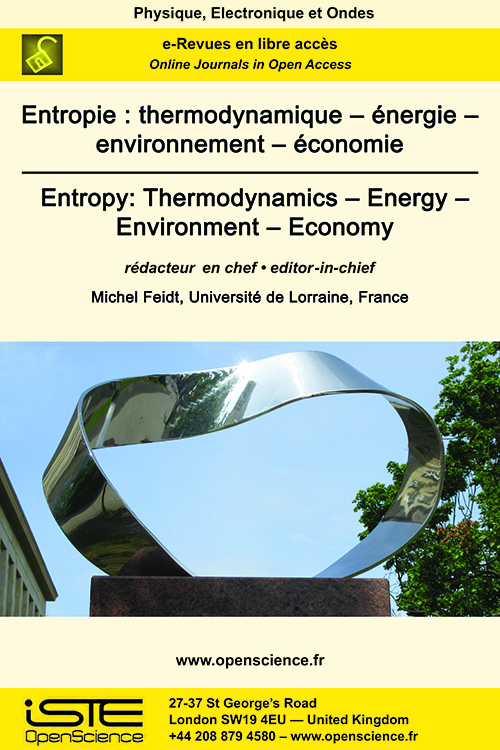

Physics > Home > Entropy: Thermodynamics – Energy – Environment – Economy > Issue
This paper reconsiders the modelling of Curzon-Ahlborn dedicated to Carnot engine. A modified model is proposed, taking account of the period (duration) of the cycle. It allows a two steps optimization, by following a model incorporating internal irreversibility of the cycle. New results are obtained. We note particularly comparison of various approaches: with thermodynamics transformations according to Curzon and Ahlborn proposal versus mean values over the cycle according to Chambadal proposal. It confirms the interest of the description of irreversibilities with entropy production method preferably to the ratio method. This new approach may give rise to an extension currently under development to our initiative.
In previous works an exhaustive description has been obtained of the aggregative processes to which the ideal system described by the so called IdEP-IdLA model can be subject both in closed conditions (at equilibrium) and in open conditions (far from equilibrium). The model has shown such a thermodynamic coherence that it can be used for a theoretical study of real processes. The aim of this work is therefore to try to transfer the results obtained to the biochemical field: in particular, we here propose to investigate whether the model is able to contribute to define probabilistic requirements to which biogenesis must be subject. The reasoning leads to conclusions largely in line with the state of the art on this topic but, at the same time, opens the way to a completely innovative conjecture: the possi-bility that some phenomena can be supported by an information flow that proceeds according to an inverted time ar-row. This is the Arianna’s conjecture.
Several experiments have been carried out to confirm the Landauer’s principle, according to which the erasure of one bit of information requires a minimum energy dissipation of $$$K$$$B $$$ T$$$ Log 2. They are based on the principle of bistable memory. Further experiments on the thermal fluctuation motor principle provide a complementary point of view based on a tilt-type memory. By deepening their analysis we show that their results are sufficiently precise to conclude on the contrary that we have to modify the Landauer’s principle. Going back to the sources of Landauer’s work, we reconsider the machine imagined by Szilard to resolve the paradox of Maxwell’s demon, which led von Neumann to propose a form of equivalence between entropy and information. The study of a new variant of Szilard’s machine shows that its process does not depend on some information hold by an observer. The result is a new theoretical approach to solve the Maxwell’s paradox. It suggests the existence of a quantum phenomenon, which causes a sudden increase of entropy during the inversion or vanishing of a bit of information. The entropy variation is reversible if that inversion or vanishing is spontaneous, it is irreversible if the inversion or vanishing is forced by means of a control parameter. This theory falsifies the principle of equivalence between information and entropy, which was spread widely under the influence of Shannon and Brillouin, and which is in particular at the origin of the information paradox relating to black holes. This paradox which results from theories of Bekenstein and Hawking therefore disappears with this principle.

2025
Volume 25- 6
Issue 12024
Volume 24- 5
Special issue LILA 22023
Volume 23- 4
Issue 12022
Volume 22- 3
Issue 12021
Volume 21- 2
Special issue2020
Volume 20- 1
Issue 1